Characterization and Properties of Water-Blown Rigid Polyurethane Foams Reinforced with Silane-Modified Nanosepiolites Functionalized with Graphite
Abstract
:1. Introduction
2. Experimental
2.1. Raw Materials
2.2. Synthesis of Rigid Polyurethane Foams Reinforced with Silane-Modified Nanosepiolites Functionalized with Graphite (SFG)
2.3. Characterization of Silane-Modified Nanosepiolites Functionalized with Graphite (SFG)
2.4. Characterization of RPU Foams
2.5. Study of Foaming Kinetics by FTIR Spectroscopy
3. Results and Discussion
3.1. Characterization of SFG
3.2. Study of Rigid Polyurethane Foams with SFG
3.2.1. Density and Cellular Structure Characterization
3.2.2. Thermal Properties by Thermogravimetric Analysis
- The first stage consists of several degradation processes of the urethane bond to give back to the main precursors, alcohol and isocyanate (Scheme 1a), and to form volatile compounds such as alcohols, CO2, CO, aldehydes, amines, etc. (not shown in Scheme 1) [44,45,46,47,48,49]. Complete volatilization of the resulting chain fragments is prevented by dimerization of the isocyanate, which is tremendously reactive, releasing CO2 and generating carbodiimides. These carbodiimides react with the alcohol freed from the previous decomposition to give substituted ureas, which are relatively stable [44,45,46] (Scheme 1b). In addition, trimerization of the isocyanate can take place under certain conditions to give very thermally stable isocyanurate rings (Scheme 1c).
3.2.3. Influence of SFG on Reaction Kinetics
3.2.4. Optimization for the Polyurethane Foam Formulation Containing 6 wt% SFG
3.3. Validation of Improvement in Thermal Stability of the Polyurethane Foam Containing 6 wt% of SFG
4. Conclusions
Author Contributions
Funding
Institutional Review Board Statement
Informed Consent Statement
Data Availability Statement
Conflicts of Interest
References
- Szycher, M. Szycher’s Handbook of Polyurethanes, 2nd ed.; CRC Press: Boca Raton, FL, USA, 2012. [Google Scholar]
- Liu, D.; Hu, A. The influence of environmentally friendly flame retardants on the thermal stability of phase change polyurethane foams. Materials 2020, 13, 520. [Google Scholar] [CrossRef] [Green Version]
- Zhou, W.; Hao, S.J.; Feng, G.D.; Jia, P.Y.; Ren, X.L.; Zhang, M.; Zhou, Y.H. Properties of rigid polyurethane foam modified by tung oil-based polyol and flame-retardant particles. Polymers 2020, 12, 119. [Google Scholar] [CrossRef] [PubMed] [Green Version]
- Zagożdżon, I.; Parcheta, P.; Datta, J. Novel cast polyurethanes obtained by using reactive phosphorus-containing polyol: Synthesis, thermal analysis and combustion behaviors. Materials 2021, 14, 2699. [Google Scholar] [CrossRef]
- Czlonka, S.; Strakowska, A.; Strzelec, K.; Kairyte, A.; Kremensas, A. Melamine, silica, and ionic liquid as a novel flame retardant for rigid polyurethane foams with enhanced flame retardancy and mechanical properties. Polym. Test. 2020, 87, 106511. [Google Scholar] [CrossRef]
- Lin, Z.; Zhao, Q.; Fan, R.; Yuan, X.; Tian, F. Flame retardancy and thermal properties of rigid polyurethane foam conjugated with a phosphorus-nitrogen halogen-free intumescent flame retardant. J. Fire Sci. 2020, 38, 235–252. [Google Scholar] [CrossRef]
- Akdogan, E.; Erdem, M.; Ureyen, M.E.; Kaya, M. Rigid polyurethane foams with halogen-free flame retardants: Thermal insulation, mechanical, and flame retardant properties. J. Appl. Polym. Sci. 2020, 137, 47611. [Google Scholar] [CrossRef]
- Boehm, H.P.; Setton, R.; Stumpp, E. Nomenclature and terminology of graphite intercalation compounds. Carbon 1986, 24, 241–245. [Google Scholar] [CrossRef]
- Camino, G.; Duquesne, S.; Delobel, R.; Eling, B.; Lindsay, C.; Roels, T. Mechanism of expandable graphite fire retardant action in polyurethanes. ACS Symp. Ser. 2001, 797, 90–109. [Google Scholar]
- Acuña, P.; Li, Z.; Santiago-Calvo, M.; Villafañe, F.; Rodríguez-Perez, M.; Wang, D.-Y. Influence of the characteristics of expandable graphite on the morphology, thermal properties, fire behaviour and compression performance of a rigid polyurethane foam. Polymers 2019, 11, 168. [Google Scholar] [CrossRef] [PubMed] [Green Version]
- Yang, Y.; Dai, Z.; Liu, M.; Jiang, H.; Fan, C.; Wang, B.; Tang, G.; Wang, H. Flame retardant rigid polyurethane foam composites based on microencapsulated ammonium polyphosphate and microencapsulated expanded graphite. J. Macromol. Sci. Part A-Pure Appl. Chem. 2021, 58, 659–668. [Google Scholar] [CrossRef]
- Oliwa, R.; Ryszkowska, J.; Oleksy, M.; Auguscik-Krolikowska, M.; Gzik, M.; Barton, J.; Budzik, G. Effects of various types of expandable graphite and blackcurrant pomace on the properties of viscoelastic polyurethane foams. Materials 2021, 14, 1801. [Google Scholar] [CrossRef]
- Hu, Y.; Zhou, Z.; Li, S.; Yang, D.; Zhang, S.; Hou, Y. Flame retarded rigid polyurethane foams composites modified by aluminum diethylphosphinate and expanded graphite. Front. Mater. 2021, 7, 629284. [Google Scholar] [CrossRef]
- Chen, Y.; Luo, Y.; Guo, X.; Chen, L.; Jia, D. The synergistic effect of ionic liquid-modified expandable graphite and intumescent flame-retardant on flame-retardant rigid polyurethane foams. Materials 2020, 13, 3095. [Google Scholar] [CrossRef]
- Kausar, A. Polyurethane composite foams in high-performance applications: A review. Polym.-Plast. Technol. Eng. 2017, 57, 346–369. [Google Scholar] [CrossRef]
- Wang, F.; Tang, Q.; Duan, X.; Liang, J.; Wang, N.; Liu, H.; Liu, H. Effect of modified sepiolite nanofibers and hollow glass microspheres on performance of rigid polyurethane foams composite materials. Nanosci. Nanotechnol. Lett. 2014, 6, 524–531. [Google Scholar] [CrossRef]
- Kotal, M.; Bhowmick, A.K. Polymer nanocomposites from modified clays: Recent advances and challenges. Prog. Polym. Sci. 2015, 51, 127–187. [Google Scholar] [CrossRef] [Green Version]
- Sienkiewicz, A.; Furgal, M.; Czub, P. Synthesis and mechanical properties of epoxy-polyurethane materials filled with sepiolite. Przem. Chem. 2016, 95, 2048–2053. [Google Scholar]
- Pan, Y.; Liu, L.; Cai, W.; Hu, Y.; Jiang, S.; Zhao, H. Effect of layer-by-layer self-assembled sepiolite-based nanocoating on flame retardant and smoke suppressant properties of flexible polyurethane foam. Appl. Clay Sci. 2019, 168, 230–236. [Google Scholar] [CrossRef]
- Carretier, V.; Delcroix, J.; Pucci, M.F.; Rublon, P.; Lopez-Cuesta, J.-M. Influence of sepiolite and lignin as potential synergists on flame retardant systems in polylactide (pla) and polyurethane elastomer (pue). Materials 2020, 13, 2450. [Google Scholar] [CrossRef]
- Hejna, A. Clays as Inhibitors of Polyurethane Foams’ Flammability. Materials 2021, 14, 4826. [Google Scholar] [CrossRef] [PubMed]
- Panga, Y.; Yu, Z.; Chen, L.; Chen, H. Superhydrophobic polyurethane sponges modified by sepiolite for efficient oil-water separation. Colloids Surf. A Physicochem. Eng. Asp. 2021, 627, 127175. [Google Scholar] [CrossRef]
- Lu, H.Z.; Yi, D.L.; Chen, H.X.; Zhou, Y.; Zhang, J.L. The influence of clay-like sepiolite on the structure and properties of polyurethaneurea/sepiolite nanocomposites. Adv. Mater. Res. 2011, 399–401, 486–492. [Google Scholar] [CrossRef]
- Chen, H.; Lu, H.; Zhou, Y.; Zheng, M.; Ke, C.; Zeng, D. Study on thermal properties of polyurethane nanocomposites based on organo-sepiolite. Polym. Degrad. Stab. 2012, 97, 242–247. [Google Scholar] [CrossRef]
- Firdaus, M.Y.; Octaviani, H.; Herlini, H.; Fatimah, N. The Comparison of Clay Modifier (Cloisite Types) in Various Epoxy-Clay Nanocomposite Synthesis Methods. Mediterr. J. Chem. 2021, 11, 54–74. [Google Scholar] [CrossRef]
- Jlassi, K.; Chehimi, M.M.; Thomas, S. Clay-Polymer Nanocomposites; Elsevier: Amsterdam, The Netherlands, 2017. [Google Scholar]
- Chen, H.; Zheng, M.; Sun, H.; Jia, Q. Characterization and properties of sepiolite/polyurethane nanocomposites. Mater. Sci. Eng. A 2007, 445–446, 725–730. [Google Scholar] [CrossRef]
- ASTM International D1622/D1622M-14; Standard Test Method for Apparent Density of Rigid Cellular Plastics. ASTM International: West Conshohocken, PA, USA, 2014.
- ASTM International D6226-21; Standard Test Method for Open Cell Content of Rigid Cellular Plastics. ASTM International: West Conshohocken, PA, USA, 2021.
- Pinto, J.; Solorzano, E.; Rodriguez-Perez, M.A.; de Saja, J.A. Characterization of the cellular structure based on user-interactive image analysis procedures. J. Cell. Plast. 2013, 49, 555–575. [Google Scholar] [CrossRef]
- Estravís, S.; Tirado-Mediavilla, S.; Santiago-Calvo, M.; Ruiz-Herrero, J.L.; Villafañe, F.; Rodríguez-Pérez, M.A. Rigid polyurethane foams with infused nanoclays: Relationship between cellular structure and thermal conductivity. Eur. Polym. J. 2016, 80, 1–15. [Google Scholar] [CrossRef] [Green Version]
- Elwell, M.J.; Ryan, A.J.; Grünbauer, H.J.M.; Lieshout, H.C.V. In-situ studies of structure development during the reactive processing of model flexible polyurethane foam systems using ft-ir spectroscopy, synchrotron saxs, and rheology. Macromolecules 1996, 29, 2960–2968. [Google Scholar] [CrossRef]
- Elwell, M.J.; Ryan, A.J. An FT i.r. Study of reaction kinetics and structure development in model flexible polyurethane foam systems. Polymer 1996, 37, 1353–1361. [Google Scholar] [CrossRef]
- Ning, L.; De-Ning, W.; Sheng-Kang, Y. Crystallinity and hydrogen bonding of hard segments in segmented poly (urethane urea) copolymers. Polymer 1996, 37, 3577–3583. [Google Scholar] [CrossRef]
- Bernal, M.M.; Lopez-Manchado, M.A.; Verdejo, R. In situ foaming evolution of flexible polyurethane foam nanocomposites. Macromol. Chem. Phys. 2011, 212, 971–979. [Google Scholar] [CrossRef] [Green Version]
- Queiroz, D.P.; de Pinho, M.N.; Dias, C. Atr-ftir studies of poly (propylene oxide)/polybutadiene bi-soft segment urethane/urea membranes. Macromolecules 2003, 36, 4195–4200. [Google Scholar] [CrossRef]
- Santiago-Calvo, M.; Blasco, V.; Ruiz, C.; París, R.; Villafañe, F.; Rodríguez-Pérez, M.Á. Synthesis, characterization and physical properties of rigid polyurethane foams prepared with poly (propylene oxide) polyols containing graphene oxide. Eur. Polym. J. 2017, 97, 230–240. [Google Scholar] [CrossRef]
- Santiago-Calvo, M.; Tirado-Mediavilla, J.; Ruiz-Herrero, J.L.; Rodríguez-Pérez, M.Á.; Villafañe, F. The effects of functional nanofillers on the reaction kinetics, microstructure, thermal and mechanical properties of water blown rigid polyurethane foams. Polymer 2018, 150, 138–149. [Google Scholar] [CrossRef]
- Lazarević, S.; Janković-Častvan, I.; Jovanović, D.; Milonjić, S.; Janaćković, D.; Petrović, R. Adsorption of pb2+, cd2+ and sr2+ ions onto natural and acid-activated sepiolites. Appl. Clay Sci. 2007, 37, 47–57. [Google Scholar] [CrossRef]
- Belzunce, M.J. Modification of sepiolite by treatment with fluorides: Structural and textural changes. Clays Clay Miner. 1998, 46, 603–614. [Google Scholar] [CrossRef]
- Mazloom Jalali, A.; Afshar Taromi, F.; Atai, M.; Solhi, L. Effect of reaction conditions on silanisation of sepiolite nanoparticles. J. Exp. Nanosci. 2016, 11, 1171–1183. [Google Scholar] [CrossRef] [Green Version]
- Lima, A.M.F.; Musumeci, A.W.; Liu, H.-W.; Waclawik, E.R.; Silva, G.G. Purity evaluation and influence of carbon nanotube on carbon nanotube/graphite thermal stability. J. Therm. Anal. Calorim. 2009, 97, 257–263. [Google Scholar] [CrossRef]
- Vahedi, A.; Rahmani, M.; Rahmani, Z.; Moghaddasi, M.; Talebnia Rowshan, F.; Kazemi, A.; Mahdavi, S.Z. Application of polymer-sepiolite composites for adsorption of cu(ii) and ni(ii) from aqueous solution: Equilibrium and kinetic studies. e-Polymers 2018, 18, 217–228. [Google Scholar] [CrossRef]
- Yang, H.; Liu, H.; Jiang, Y.; Chen, M.; Wan, C. Density effect on flame retardancy, thermal degradation, and combustibility of rigid polyurethane foam modified by expandable graphite or ammonium polyphosphate. Polymers 2019, 11, 668. [Google Scholar] [CrossRef] [Green Version]
- Chattopadhyay, D.K.; Webster, D.C. Thermal stability and flame retardancy of polyurethanes. Prog. Polym. Sci. 2009, 34, 1068–1133. [Google Scholar] [CrossRef]
- Berta, M.; Lindsay, C.; Pans, G.; Camino, G. Effect of chemical structure on combustion and thermal behaviour of polyurethane elastomer layered silicate nanocomposites. Polym. Degrad. Stab. 2006, 91, 1179–1191. [Google Scholar] [CrossRef]
- Reinerte, S.; Jurkjane, V.; Cabulis, U.; Viksna, A. Identification and Evaluation of Hazardous Pyrolysates in Bio-Based Rigid Polyurethane-Polyisocyanurate Foam Smoke. Polymers 2021, 13, 3205. [Google Scholar] [CrossRef] [PubMed]
- Reinerte, S.; Avotina, L.; Zarins, A.; Cabulis, U.; Viksna, A. TG/DTA-FTIR as a method for analysis of tall oil based rigid polyurethane foam decomposition gaseous products in a low oxygen environment. Polym. Degrad. Stab. 2020, 180, 109313. [Google Scholar] [CrossRef]
- Reinerte, S.; Kirpluks, M.; Cabulis, U. Thermal degradation of highly crosslinked rigid PU-PIR foams based on high functionality tall oil polyol. Polym. Degrad. Stab. 2019, 167, 50–57. [Google Scholar] [CrossRef]
- Debelak, B.; Lafdi, K. Use of exfoliated graphite filler to enhance polymer physical properties. Carbon 2007, 45, 1727–1734. [Google Scholar] [CrossRef]
- Wi, S.; Berardi, U.; Loreto, S.D.; Kim, S. Microstructure and thermal characterization of aerogel-graphite polyurethane spray-foam composite for high efficiency thermal energy utilization. J. Hazard. 2020, 397, 122656. [Google Scholar] [CrossRef]
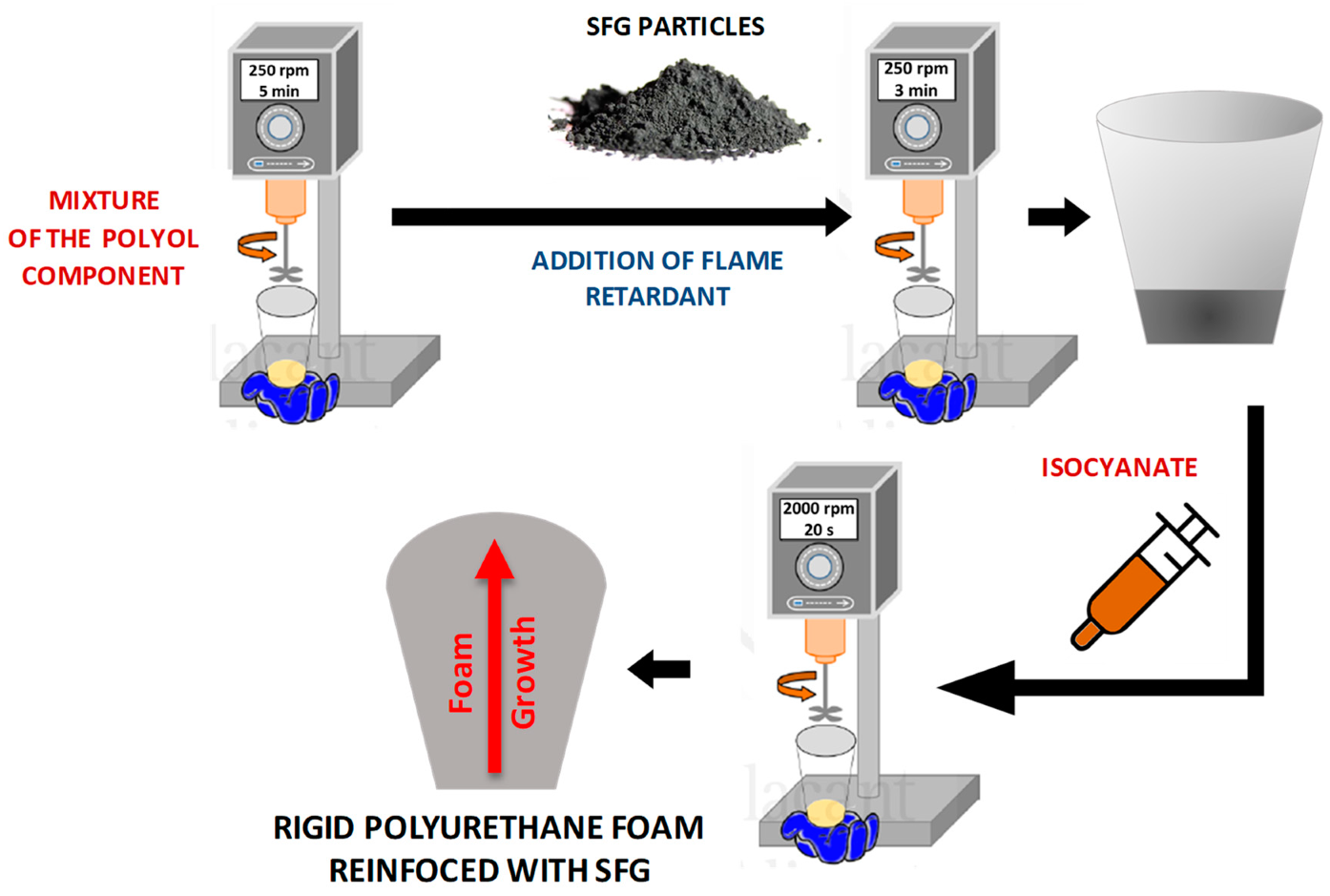


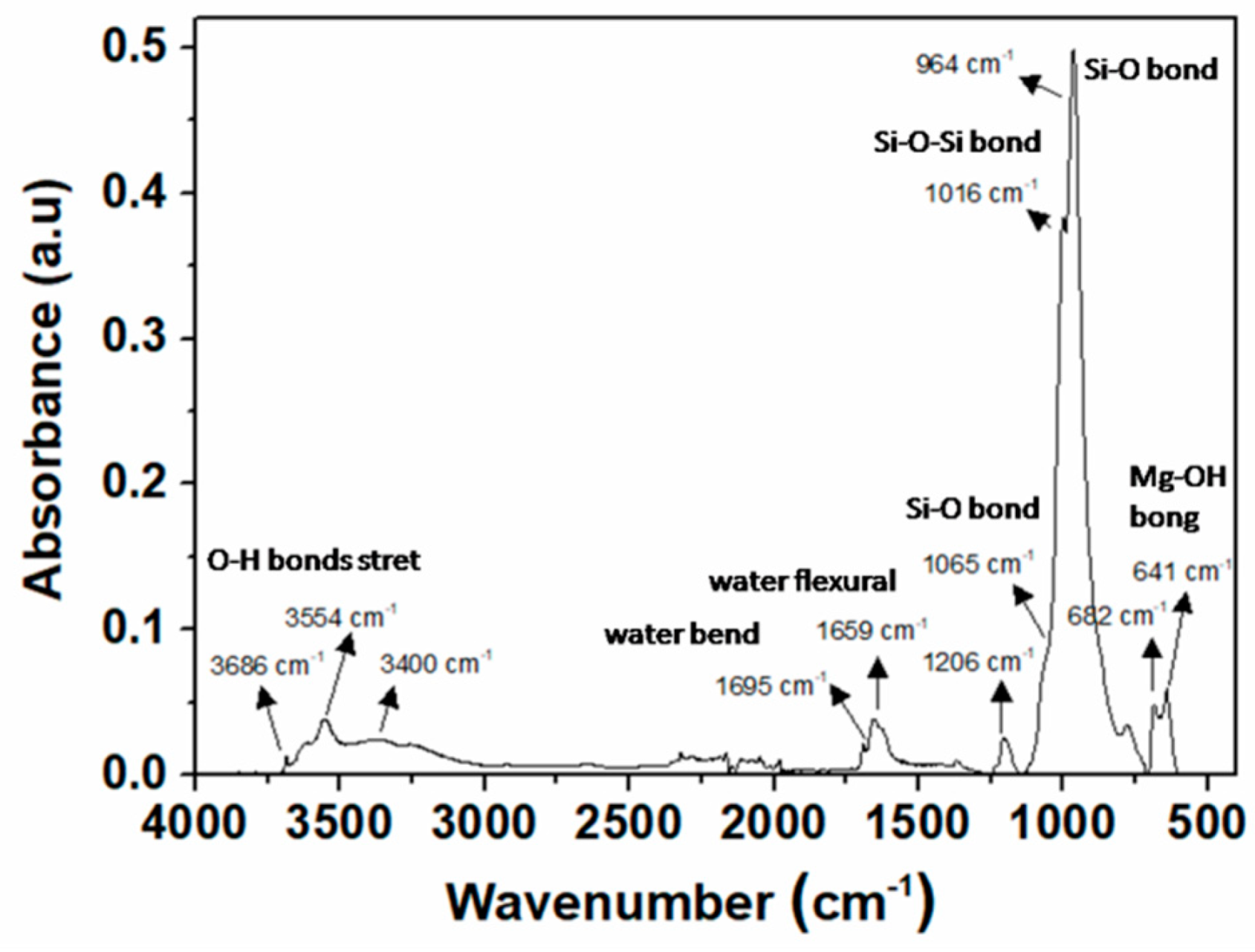




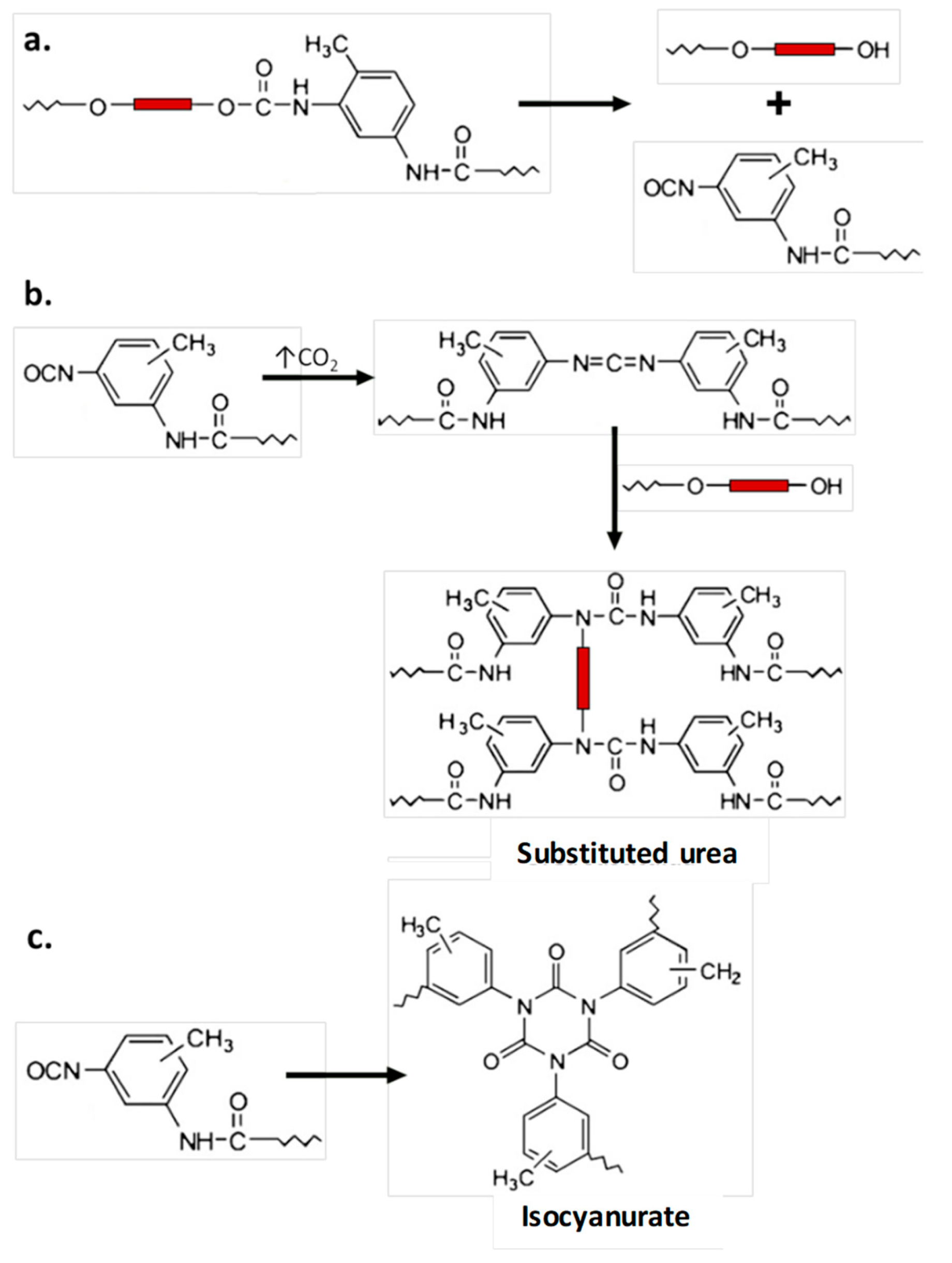
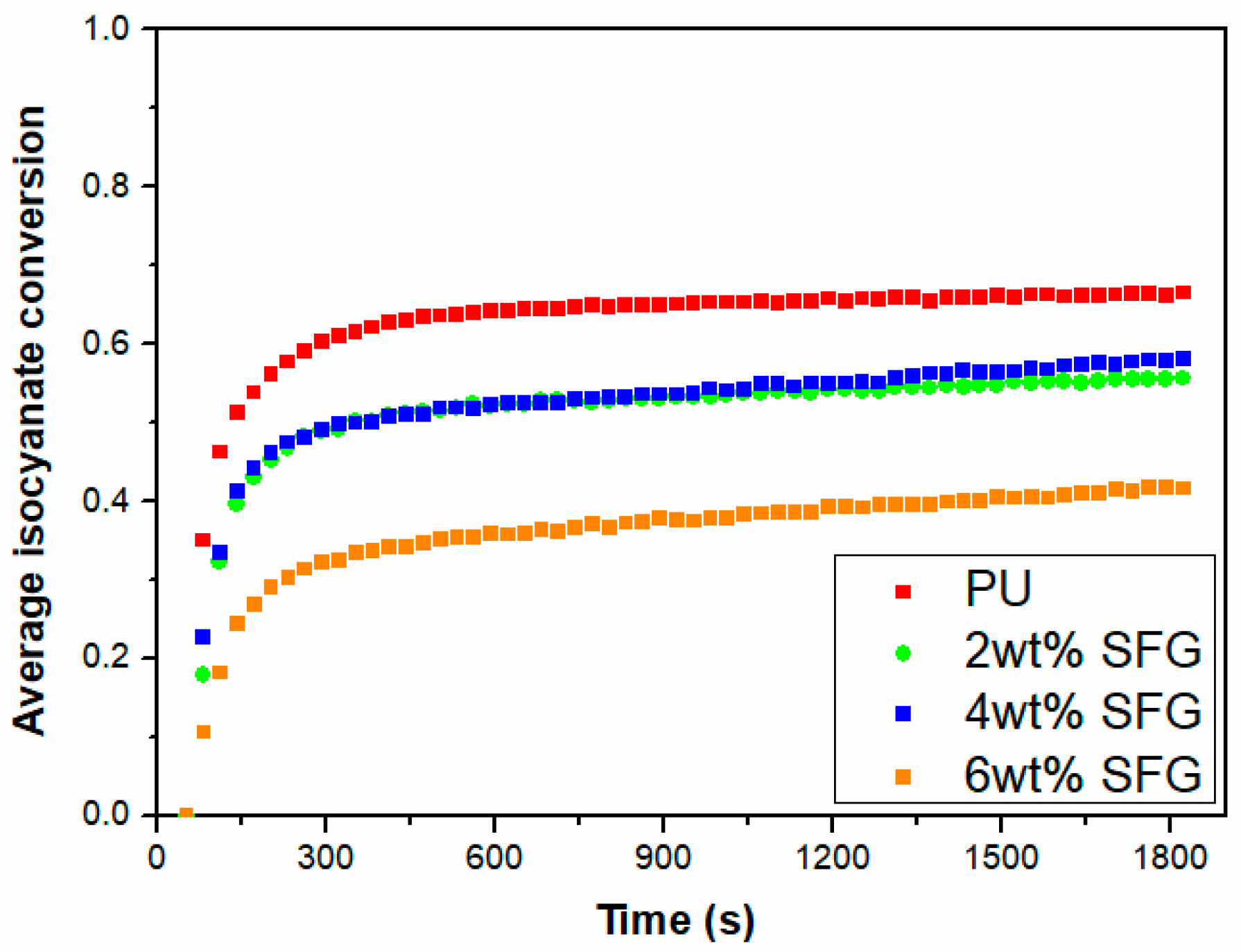




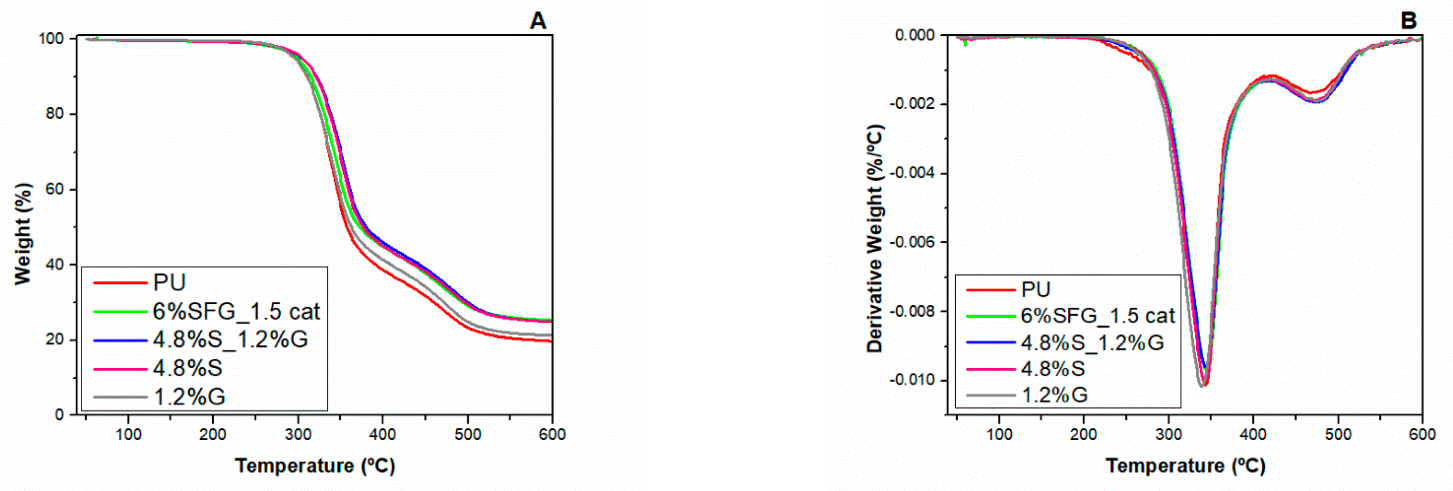
| Samples | Polyol Component | Isocyanate Component | ||||
|---|---|---|---|---|---|---|
| SFG [wt%] | Polyol [ppw] | Surfactant [ppw] | Catalyst [ppw] | Blowing Agent (Water) [ppw] | Isocyanate Index | |
| PU-Reference | 0 | 100 | 1 | 1 | 6 | 120 |
| 2 wt% SFG | 2 | 100 | 1 | 1 | 6 | 120 |
| 4 wt% SFG | 4 | 100 | 1 | 1 | 6 | 120 |
| 6 wt% SFG | 6 | 100 | 1 | 1 | 6 | 120 |
| Samples | Polyol Component | Isocyanate Component | ||||
|---|---|---|---|---|---|---|
| SFG [wt%] | Polyol [ppw] | Surfactant [ppw] | Catalyst [ppw] | Blowing Agent (Water) [ppw] | Isocyanate Index | |
| PU-Reference | 0 | 100 | 1 | 1 | 6 | 120 |
| 6 wt% SFG_1 ppw cat | 6 | 100 | 1 | 1 | 6 | 120 |
| 6 wt% SFG_1.25 ppw cat | 6 | 100 | 1 | 1.25 | 6 | 120 |
| 6 wt% SFG_1.5 ppw cat | 6 | 100 | 1 | 1.5 | 6 | 120 |
| Samples | Polyol Component | Isocyanate Component | ||||||
|---|---|---|---|---|---|---|---|---|
| SFG [wt%] | S [wt%] | G [wt%] | Polyol [ppw] | Surfactant [ppw] | Catalyst [ppw] | Blowing Agent (Water) [ppw] | Isocyanate Index | |
| PU-Reference | 0 | 0 | 0 | 100 | 1 | 1 | 6 | 120 |
| 6 wt% SFG_1.25 ppw cat | 6 | 0 | 0 | 100 | 1 | 1.25 | 6 | 120 |
| 4.8 wt% S_1.2 wt% G | 0 | 4.8 | 1.2 | 100 | 1 | 1.25 | 6 | 120 |
| 4.8 wt% S | 0 | 4.8 | 0 | 100 | 1 | 1.25 | 6 | 120 |
| 1.2 wt% G | 0 | 0 | 1.2 | 100 | 1 | 1.25 | 6 | 120 |
| Samples | Density (kg/m3) | OC (%) | Φ3D (μm) | NSD | AR |
|---|---|---|---|---|---|
| PU-Reference | 27.0 ± 0.1 | 2.7 ± 1.0 | 340 ± 90 | 0.26 | 1.1 ± 0.2 |
| 2 wt% SFG | 29.1 ± 0.3 | 6.5 ± 0.9 | 390 ± 100 | 0.24 | 1.0 ± 0.2 |
| 4 wt% SFG | 29.9 ± 0.3 | 12.9 ± 1.0 | 390 ± 100 | 0.24 | 1.0 ± 0.2 |
| 6 wt% SFG | 31.8 ± 0.4 | 17.6 ± 1.2 | 500 ± 220 | 0.44 | 1.2 ± 0.3 |
| Samples | Viscosity at 25 °C (mPa·s) |
|---|---|
| Polyol | 510 ± 20 |
| Polyol/2 wt% SFG | 6300 ± 50 |
| Polyol/4 wt% SFG | 8280 ± 60 |
| Polyol/6 wt% SFG | 10,900 ± 100 |
| Samples | 1st Step | 2nd Step | |||||
|---|---|---|---|---|---|---|---|
| T5 (°C) | Tmax1 (°C) | DTG max1 (%/°C) | Residue (%) | Tmax2 (°C) | DTG max2 (%/°C) | Residue (%) | |
| PU-Reference | 295.4 ± 0.0 | 341.9 ± 0.6 | −0.0109 | 35.9 ± 0.2 | 474.1 ± 0.0 | −0.0018 | 19.8 ± 0.8 |
| 2 wt% SFG | 292.3 ± 0.1 | 341.0 ± 0.2 | −0.0098 | 39.7 ± 0.2 | 472.6 ± 0.4 | −0.0018 | 22.7 ± 0.1 |
| 4 wt% SFG | 293.7 ± 0.7 | 343.0 ± 0.1 | −0.0098 | 40.8 ± 0.2 | 472.7 ± 1.0 | −0.0018 | 24.4 ± 0.4 |
| 6 wt% SFG | 288.4 ± 1.4 | 343.1 ± 0.1 | −0.0100 | 41.1 ± 0.3 | 474.5 ± 0.0 | −0.0016 | 26.1 ± 0.3 |
| Samples | Density (kg/m3) | OC (%) | Φ3D (μm) | NSD | AR |
|---|---|---|---|---|---|
| 6 wt% SFG_1 ppw cat | 31.8 ± 0.4 | 17.6 ± 1.2 | 500 ± 220 | 0.44 | 1.2 ± 0.3 |
| 6 wt% SFG_1.25 ppw cat | 30.7 ± 0.3 | 10.6± 1.4 | 400 ± 140 | 0.35 | 1.0 ± 0.2 |
| 6 wt% SFG_1.5 ppw cat | 28.7 ± 0.6 | 7.9 ± 1.0 | 440 ± 160 | 0.36 | 0.9 ± 0.2 |
| Samples | Density (kg/m3) | OC (%) | Φ3D (μm) | NSD | AR | Thermal Conductivity (mW/mK) |
|---|---|---|---|---|---|---|
| PU-Reference | 27.0 ± 0.1 | 2.7 ± 1.0 | 340 ± 90 | 0.26 | 1.1 ± 0.2 | 36.9 ± 0.2 |
| 6 wt% SFG_1.5 ppw cat | 28.7 ± 0.6 | 7.9 ± 1.0 | 440 ± 160 | 0.36 | 0.9 ± 0.2 | 38.2 ± 0.3 |
| 4.8 wt% S_1.2 wt% G | 30.5 ± 0.5 | 25.4 ± 3.3 | 540 ± 200 | 0.37 | 1.0 ± 0.3 | 39.1 ± 0.2 |
| 4.8 wt% S | 30.0 ± 0.9 | 47.0 ± 2.2 | 590 ± 180 | 0.31 | 1.0 ± 0.2 | 38.8 ± 0.2 |
| 1.2 wt% G | 29.3 ± 0.4 | 4.2 ± 1.9 | 360 ± 130 | 0.37 | 1.2 ± 0.3 | 38.4 ± 0.1 |
| Samples | First Step | Second Step | |||||
|---|---|---|---|---|---|---|---|
| T5 (°C) | Tmax1 (°C) | DTG max1 (%/°C) | Residue (%) | Tmax2 (°C) | DTG max2 (%/°C) | Residue (%) | |
| PU-Reference | 295.4 ± 0.0 | 341.9 ± 0.6 | −0.0109 | 35.9 ± 0.2 | 474.1 ± 0.0 | −0.0018 | 19.8 ± 0.8 |
| 6 wt% SFG_1.5 ppw cat | 297.8 ± 0.7 | 344.0 ± 0.1 | −0.0094 | 42.5 ± 0.1 | 473.8 ± 0.3 | −0.0019 | 25.3 ± 0.0 |
| 4.8 wt% S_1.2 wt% G | 295.3 ± 0.0 | 344.4 ± 0.8 | −0.0095 | 42.2 ± 0.2 | 475.0 ± 0.6 | −0.0019 | 24.7 ± 0.3 |
| 4.8 wt% S | 295.6 ± 0.1 | 342.7 ± 0.4 | −0.0098 | 42.4 ± 0.4 | 473.8 ± 0.5 | −0.0019 | 24.8 ± 0.9 |
| 1.2 wt% G | 294.6 ± 1.3 | 338.8 ± 0.2 | −0.0105 | 39.2 ± 0.1 | 474.8 ± 0.3 | −0.0017 | 21.5 ± 0.5 |
Publisher’s Note: MDPI stays neutral with regard to jurisdictional claims in published maps and institutional affiliations. |
© 2022 by the authors. Licensee MDPI, Basel, Switzerland. This article is an open access article distributed under the terms and conditions of the Creative Commons Attribution (CC BY) license (https://creativecommons.org/licenses/by/4.0/).
Share and Cite
Santiago-Calvo, M.; Carracedo-Pérez, M.; Puertas, M.L.; Esteban-Cubillo, A.; Santaren, J.; Villafañe, F.; Rodríguez-Pérez, M.-Á. Characterization and Properties of Water-Blown Rigid Polyurethane Foams Reinforced with Silane-Modified Nanosepiolites Functionalized with Graphite. Materials 2022, 15, 381. https://doi.org/10.3390/ma15010381
Santiago-Calvo M, Carracedo-Pérez M, Puertas ML, Esteban-Cubillo A, Santaren J, Villafañe F, Rodríguez-Pérez M-Á. Characterization and Properties of Water-Blown Rigid Polyurethane Foams Reinforced with Silane-Modified Nanosepiolites Functionalized with Graphite. Materials. 2022; 15(1):381. https://doi.org/10.3390/ma15010381
Chicago/Turabian StyleSantiago-Calvo, Mercedes, María Carracedo-Pérez, María Luisa Puertas, Antonio Esteban-Cubillo, Julio Santaren, Fernando Villafañe, and Miguel-Ángel Rodríguez-Pérez. 2022. "Characterization and Properties of Water-Blown Rigid Polyurethane Foams Reinforced with Silane-Modified Nanosepiolites Functionalized with Graphite" Materials 15, no. 1: 381. https://doi.org/10.3390/ma15010381
APA StyleSantiago-Calvo, M., Carracedo-Pérez, M., Puertas, M. L., Esteban-Cubillo, A., Santaren, J., Villafañe, F., & Rodríguez-Pérez, M.-Á. (2022). Characterization and Properties of Water-Blown Rigid Polyurethane Foams Reinforced with Silane-Modified Nanosepiolites Functionalized with Graphite. Materials, 15(1), 381. https://doi.org/10.3390/ma15010381








